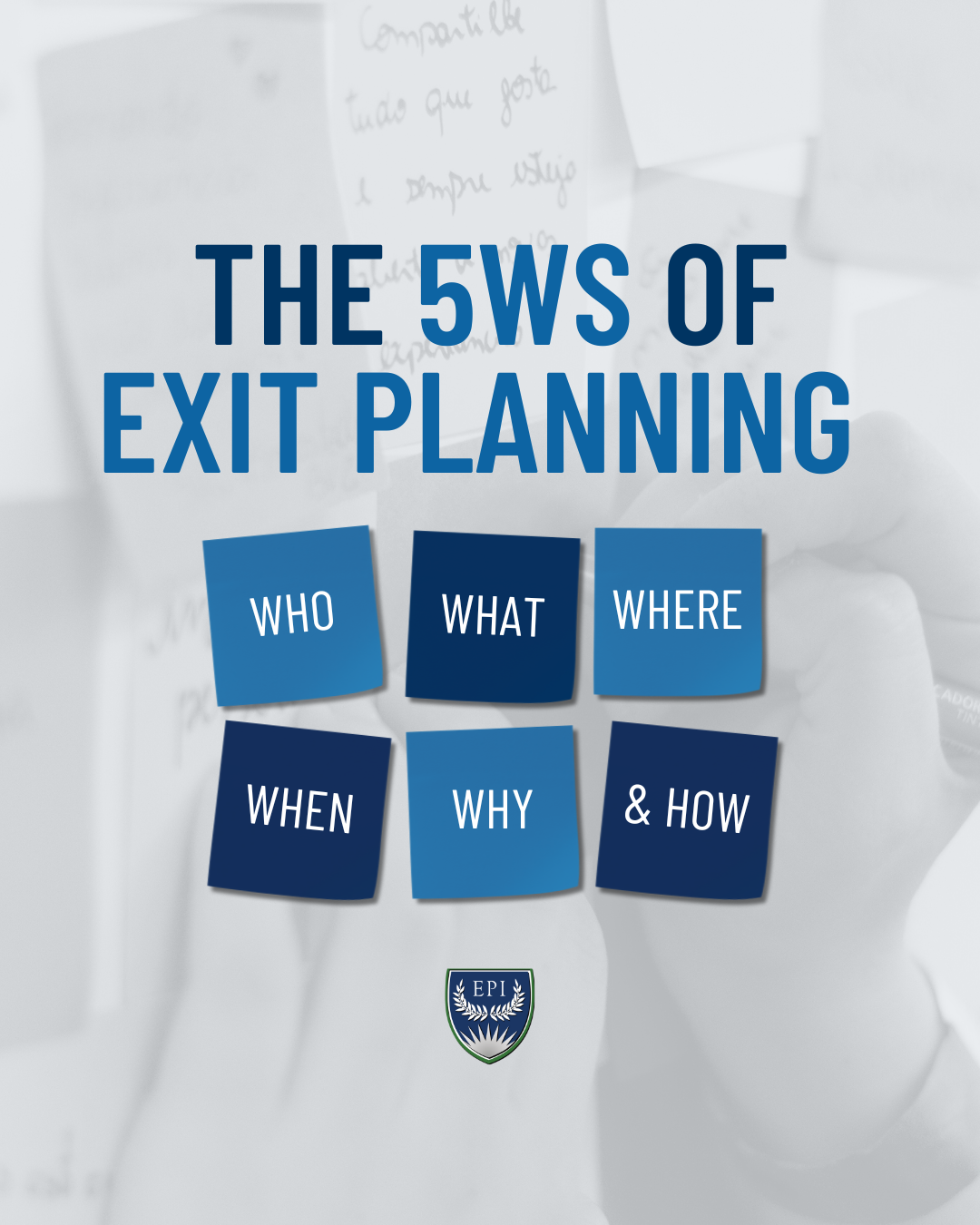
THE EXIT PLANNING BLOG
Keep up-to-date with exit planning, succession planning, industry trends, unique specialty insights, and useful content for professional advisors and business owners.
Share this
You're Not "Alone" in Your Exit Plan: How to Survive Exiting Your Business
by Colleen Kowalski on September 1, 2023

Picture this: You and 16 strangers are sitting side to side on a tiny boat as the waves rock you back and forth. You see a small island in the distance. Standing on the beach is a man wearing khaki shorts, a blue button-down shirt, and a baseball hat that has seen better days. You recognize him immediately: Jeff Probst, the host of Survivor for the past 23 years.
You and your fellow castaways make your way to the shores as you prepare to spend 26 days in the wilderness with nothing but the supplies you can carry from the boat. The question is, what have you done to prepare for this journey?
Just like contestants on Survivor, and the more realistic survivalist show Alone, must devise winning strategies to outlast their competition and secure the ultimate prize, business owners must also navigate a challenging terrain to achieve a successful exit from their companies.
We spoke with CEPA and Survivor and Alone enthusiast, Ryan Bly, to see how owners can incorporate lessons from these survival shows into their exit planning.
What Do You Bring to the Island?
On both Survivor and Alone the contestants are able to bring a few items that will help them survive in the wilderness for an extended period of time. As a fan of both shows, Ryan has his list of essential survival items secured. He shares, “I was an Eagle Scout, so I would bring a multi-tool, sleeping bag, knife, tarps, backpack, saw, fishing line and hooks, ferro rod, paracord… and a satellite phone to door dash food.”
As a business owner looking to “survive” in their business, Ryan recommends the owner “remember your north star of why you are in business and make your decisions accordingly.” To reach a significant value during the exit, owners should review their financials, de-risk the Five Ds, and know their three gaps.
Building a Strong Alliance
Survivor is known for their alliances and teams. In order to make it to the end of the show, castaways form teams with complementary skill sets and personalities. Who should an owner look for to create a strong team during their exit planning process? What advisors should make up the core exit planning team?
Ryan recommends an owner form their team of CEPAs. He continues, "Assemble your team ideally of all CEPAs from different disciplines so they have a shared language and methodology on how they collaborate to meet your goals. The team should include an attorney, banker, tax professional, estate planner, financial advisor, value advisor, family business advisor, M&A or investment banker, risk advisor, and board of advisors.”
Checking In Along the Way
In Alone the contestants receive regular check-ins with medical teams to make sure they can continue on in the process. These check-ins assess a variety of medical and mental stressors that can impact their ability to survive in the wilderness. What sort of check-ins should a business owner complete to make sure they are on the right track for their exit strategy?
Ryan meets regularly with his owner clients to ensure they are well prepared for their exit. He shares, “I meet quarterly with clients to review their personal financial plan, 401(k), investments, etc. and if need be, remind them to meet every 90 days with their value advisor to ensure they are making progress on their big rocks. The entire team should have regular check-ins to coordinate planning and advice through the Value Acceleration Methodology.”
Reacclimating to Life After “The Show”
Those who take part in survival shows often face challenges trying to reacclimate to their lives after the show ends. Especially in Alone, where the contestants can spend up to 100 days in the wilderness, the transition back to civilization can be daunting. After exiting their business, owners can face a similar struggle in their lives. They have spent years in their business as a business owner and after exiting, they lose a part of their identity that was tied to their business.
Ryan shares, “A business owner’s identity is wrapped up in their business. It is how they introduce themselves. Think Bob Vance, who introduces himself as “Bob Vance, Vance Refrigeration” from The Office. Business owners often want to jump right to tackling some of the quantifiable items they think financial advisors do like investment management of their existing investments and how that will look after selling the company, de-risking a company through insurance, and 401(k) benchmarking. However, I spend a greater amount of time helping the owner and their spouse envision what life will look like after their exit. I guide them through a conversation around their personal goals without assigning dollar amounts to them right away.”
When working with transitioning owners, Ryan asks the following questions:
“Fast forward to after your exit. How will you introduce yourself?”
This helps them think of their identity outside of the business.
“You often work 10-15 hour days working in your business. How will you spend your time after you take a step back from the business or exit the business?”
Free time is completely the opposite once a business owner steps away from their company. They are so used to working, eating, and sleeping, on repeat, and haven’t paused to think about what they will do with 10-15 hours of no meetings, sales calls, etc.
“What would a ‘perfect’ exit look like to you?”
It’s a great way to find out their goals for the exit planning process. Then we try to give them exactly what they want or manage expectations if they are in conflict with other goals.
“What is your wish list of things you’ve put off because you were ‘too busy’ with work?”
Trying to find a passion outside of the company they built is a process. I make sure they take the time to write down aspirational dreams or values they’ve set aside to feel excited for this new chapter in their life.
“What are some things that concern you or worry about the exit planning process?”
Address this head-on to avoid roadblocks to their progress. So many times, we can get derailed in the process and how they answer this question gives us a roadmap to avoid as many issues as possible.
Just as contestants on Survivor and Alone strategize to outlast their competition and secure victory, business owners must carefully plan their exits to achieve their desired outcomes. By drawing parallels between these reality TV shows and exit planning, entrepreneurs can gain valuable insights into the challenges and strategies required to reach significant exits.
Share this
- Blog (544)
- CEPA (419)
- exit planning (249)
- CEPA community (187)
- Business Owner (170)
- Exit Planning Summit (95)
- EPI Chapter Network (89)
- Value Acceleration Methodology (79)
- Exit Planning Partner Network (76)
- EPI Announcement (49)
- Content (48)
- Webinars (37)
- Excellence in Exit Planning Awards (33)
- Marketing (30)
- 2024 Exit Planning Summit (28)
- 5 Stages of Value Maturity (26)
- Books (24)
- EPI Academy (24)
- EPI Team (22)
- Exit Planning Teams (22)
- Leadership (21)
- 2023 Exit Planning Summit (20)
- family business (20)
- women in business (19)
- Intangible Capital (18)
- Exit Options (17)
- Black Friday (16)
- CPA (15)
- Walking to Destiny (15)
- State of Owner Readiness (14)
- Chapters (13)
- Chris Snider (12)
- National Accounts (12)
- Small business (12)
- charitable intent (12)
- personal planning (12)
- Financial Advisors (11)
- Season of Deals (9)
- 5 Ds (8)
- About us (8)
- Podcast (8)
- Insiders Bash (7)
- Scott Snider (7)
- Christmas (6)
- Exit Planning Content Library (6)
- Case Studies (5)
- Owner Roundtables (5)
- Value Advisors (5)
- financial planning (5)
- Awards (4)
- Circle of Excellence (4)
- Exit & Succession (4)
- Five Ds (4)
- Three Legs of the Stool (4)
- executive training (4)
- Owners Forum (3)
- author (3)
- forbes (3)
- DriveValue (2)
- EPI Thought Leadership Council (2)
- Exit Is Now Podcast (2)
- Peter Christman (2)
- Veteran (2)
- Whitepapers (2)
- Business Owners Forum (1)
- SOOR (1)
- business consultants (1)






